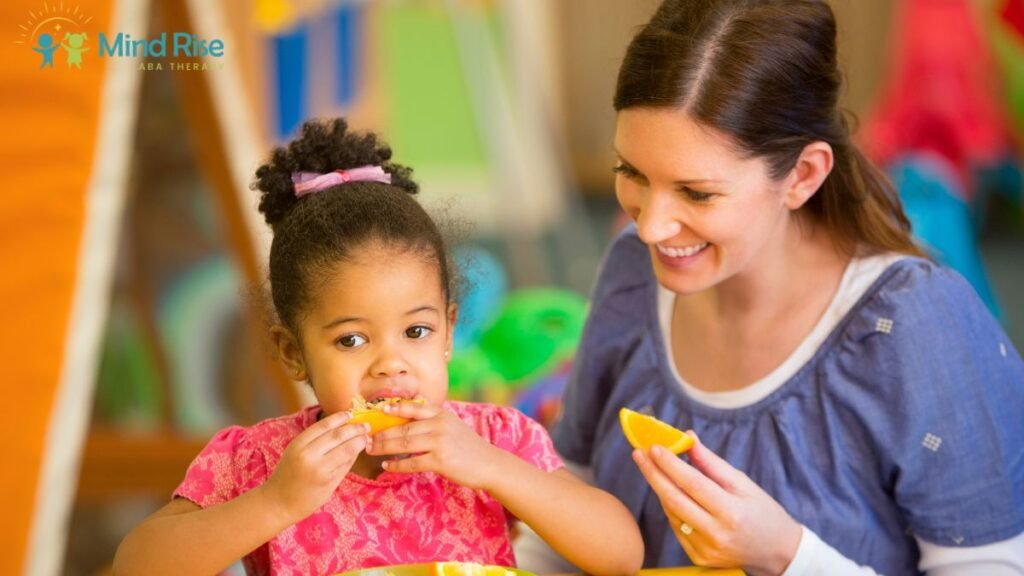Key Points:
- Naturalistic teaching in ABA uses everyday routines and play to build communication, social, and life skills.
- Core strategies include incidental teaching, pivotal response training, milieu teaching, and natural environment teaching.
- Practical examples at home, school, and in the community help children generalize skills beyond therapy sessions.
- Parents and teachers benefit from aligning on consistent methods to increase independence and reduce frustration.
Parents often worry when progress made in therapy doesn’t carry over to daily life. A child may label colors at the table with a therapist but stay quiet at home. This gap makes families wonder how to help children learn skills where they are needed most: during meals, play, and school.
Naturalistic teaching ABA strategies address this by embedding learning into natural environments. Instead of sitting for drills, children practice communication, social, and self-help skills during real routines. Up next, we’ll walk you through how this approach helps children apply skills across different settings.

What Is Naturalistic Teaching in ABA?
Naturalistic teaching is an evidence-based approach in Applied Behavior Analysis (ABA) where teaching moments occur during natural activities. Unlike discrete trial training (DTT), which is highly structured, naturalistic strategies emphasize child-led learning and generalization. The main principles include:
- Using natural contexts: Skills are taught in daily routines like eating, dressing, or
- playing.
- Child-led activities: Motivation comes from what the child is already interested in.
- Immediate reinforcement: Access to a desired item or activity follows correct responses.
- Focus on generalization: Skills are practiced in different settings to ensure carryover.
By teaching in real-life contexts, children learn how to use skills where they matter most.
Why Naturalistic ABA Is Effective
Parents often ask why naturalistic teaching matters if their child is already making progress in structured ABA. The answer lies in generalization. Many children can perform skills in therapy but fail to apply them at home or school. For example:
- A child may answer questions during flashcard drills but stay silent when asked by a teacher.
- A child may follow directions in a therapy room but resist when asked to clean up toys at home.
Naturalistic teaching ABA addresses this by making practice happen in the same environments where children live and learn. Its benefits include:
- Reduced frustration for children and parents.
- More opportunities for spontaneous communication.
- Increased independence in routines like eating, dressing, and school tasks.
- Stronger collaboration between families, teachers, and therapists.

Core Naturalistic Teaching ABA Strategies
1. Incidental Teaching
Incidental teaching occurs when an adult uses a child’s interest to create a learning opportunity. The adult waits for the child to initiate and then prompts communication or problem-solving. Here’s how it works:
- Arrange the environment with motivating items.
- Wait for the child to show interest.
- Prompt the desired skill (e.g., requesting, labeling).
- Reinforce immediately.
Example: A child sees bubbles on the table. Instead of handing them over, the adult prompts, “What do you want?” The child responds with “bubbles” and is rewarded with bubble play.
2. Pivotal Response Training (PRT)
PRT targets pivotal skills that influence many other areas of development. These include motivation, self-management, initiation, and responding to multiple cues. It employs the following:
- Allow choice to increase motivation.
- Use natural reinforcers (e.g., playing with the toy requested).
- Mix tasks to keep engagement high.
Example: A child loves cars. During play, the therapist pauses and waits for the child to say “car” or “push.” This encourages initiation and builds motivation to communicate.
A 2023 randomized clinical trial found that when mothers received PRT training, their children (ages 2–6, including nonverbal children) showed significant gains in speech, language, and socialization scores gains that held steady one month after the intervention.
3. Milieu Teaching
Milieu teaching involves structuring the environment so children must use communication to access items or activities:
- Place desired items slightly out of reach.
- Use prompts such as “What do you want?” or “Tell me more.”
- Reinforce attempts and expand responses gradually.
Example: A child’s favorite toy is placed on a shelf. The parent waits for the child to request help, then prompts a full sentence: “I want the truck.”
4. Natural Environment Teaching (NET)
NET involves embedding teaching opportunities across daily activities rather than separate practice sessions:
- Identify target skills.
- Incorporate them into everyday routines.
- Use natural consequences as reinforcement.
Example: During cooking, a child practices labeling (“spoon,” “milk”) and counting (“two cups of water”). These are ABA goals practiced in a meaningful context.

Practical Examples of Naturalistic Teaching
At Home
- Mealtime: Encourage requests for utensils, drinks, or favorite foods. Example: waiting for the child to say “juice” before pouring.
- Playtime: Prompt sharing and turn-taking during board games or pretend play.
- Bedtime routine: Use brushing teeth to practice sequencing (“first toothpaste, then brush”).
At School
- Circle time: Prompt greetings and eye contact during morning check-ins.
- Learning stations: Encourage requesting materials like crayons or books.
- Recess: Support turn-taking on swings or slides.
In the Community
- Grocery store: Ask the child to find items or request them at checkout.
- Playground: Encourage waiting, requesting a push, or greeting peers.
- Restaurants: Support ordering food or asking staff for water.
These examples show how parents and teachers can practice ABA goals without adding extra work, simply by pausing and prompting during natural moments.
Tips for Parents Using Naturalistic ABA
- Follow your child’s interests. Motivation is stronger when the activity is fun.
- Use short pauses. Give time for the child to initiate instead of rushing in.
- Celebrate all attempts. Reinforce approximations, then shape toward full responses.
- Stay consistent. Use the same strategies across home and school.
- Keep it fun. Children learn best when the interaction feels playful, not like a test.
Common Challenges and Solutions
- Child avoids interaction: Use preferred toys or snacks to spark engagement.
- Limited speech: Start with gestures or single words and build gradually.
- Inconsistent carryover: Share strategies with teachers and caregivers for alignment.
A 2023 meta‑analysis found that parent‑mediated interventions improved daily living skills in children with ASD more than interventions delivered solely in clinic settings. This highlights the importance of caregiver involvement.
Turn Daily Moments into Lasting Skills
Naturalistic ABA strategies help children learn where it matters most: at home, at school, and in the community. These approaches encourage communication, independence, and participation by using routines families already follow.
Families seeking ABA therapy services in Virginia can find support that adapts to daily life and strengthens long-term growth. Mind Rise ABA partners with parents to apply naturalistic teaching strategies that create meaningful progress for children.
Get in touch today to learn how ABA therapy can help your child grow communication, independence, and confidence in daily life.

